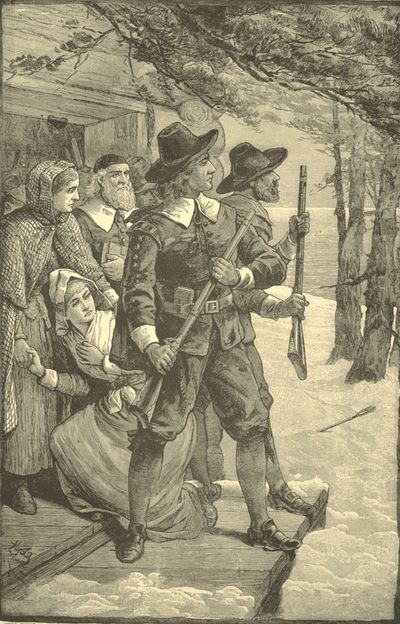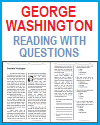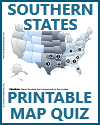| A Puritan Christmas |
|---|
| www.studenthandouts.com ↣ U.S. History ↣ Colonial Period ↣ Maps and Pictures |
 |
    |
|
The Puritans who settled in North America eschewed Christmas celebrations. This was because, in 17th-century England, Christmas was a holiday celebrated by drinking alcohol, dancing, and carousing, all things despised by the Puritans. It was not until the late 1900s that Christmas became a popular holiday in the United States. Click here to enlarge.
Nineteenth-century depictions of American colonists as strong and brave are influenced by several factors, including historical events, cultural context, and the desire to create a national identity and mythos. Historical Perspective: In the 19th century, the American Revolution and the early colonial period were relatively recent events, and the United States was still a young nation. Americans looked back to these foundational moments in their history with pride and nostalgia. Nation-Building and Patriotism: The 19th century was a time of nation-building in the United States. As the country expanded westward, there was a need to create a unifying national identity and narrative. celebrating the bravery and strength of early colonists and revolutionaries helped foster a sense of patriotism and unity. Romanticism: The 19th century was characterized by the Romantic movement, which emphasized emotion, individualism, and a connection to nature. Romantic ideals often colored depictions of historical figures and events, portraying them in heroic and idealized terms. Cultural Myths: The image of the strong and brave American colonist became part of the cultural mythology of the United States. These depictions were used to inspire and instill a sense of national pride in citizens. Educational Curricula: In the 19th century, American education increasingly included the teaching of history as a means of instilling civic values. Textbooks and curriculum materials often portrayed early colonists and patriots as exemplars of virtue and bravery. Political Ideals: The 19th century saw the expansion of democratic ideals, and early American colonists were sometimes portrayed as courageous fighters for liberty and freedom. This narrative served to reinforce the values of democracy and self-governance. Cultural Memory: Historical figures like George Washington, Thomas Jefferson, and Paul Revere were celebrated and memorialized in the 19th century. The stories of their bravery and leadership during the Revolutionary War contributed to the image of strong and fearless colonists. Manifest Destiny: As the United States expanded westward, the idea of manifest destiny—the belief that it was America's destiny to expand across the continent—grew. Popular belief in the courage and tenacity of early colonists served as a model for those who ventured into new territories. Artistic Representations: Visual arts, literature, and popular culture of the 19th century often depicted early colonists and revolutionaries in heroic and larger-than-life ways. These artistic representations reinforced the image of strong and brave colonists. It is important to note that these depictions often idealized and simplified the historical reality. The actual experiences of early colonists were complex, including periods of struggle, hardship, conflict with Native Americans, and divisions within colonial society. However, the 19th-century portrayal of colonists as strong and brave played a significant role in shaping the American national identity and collective memory, helping to create a narrative of exceptionalism and resilience. |
| Colonial Period Books and Films | Colonial Period Learning and Study Games |
| Colonial Period Image Galleries | Colonial Period Outlines and PowerPoints |
| Colonial Period Miscellany | Colonial Period Worksheets |
| www.studenthandouts.com ↣ U.S. History ↣ Colonial Period ↣ Maps and Pictures |








